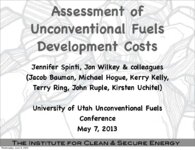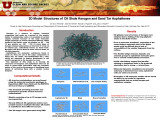TO
Filters: Collection: "ir_eua"
| Title | Date | Subject | Description | ||
|---|---|---|---|---|---|
| 226 |
 |
APPENDIX G - Detailed study of shale pyrolysis for oil production - A subpart of project oil shale pyrolysis and in situ modeling - Final Project Report - Reporting period: June 21, 2006 to October 21, 2009 | 2009-04-21 | Oil production; Shale assessment | The oil shale industry is going through a revolution of sorts. After the oil crisis in the 1970s, a great deal of effort was spent on research and development and on pilot scale technologies. Extensive research was conducted with on-surface and in-situ production methods. Even though some large pilo... |
| 227 |
 |
Application of a self-adaptive detector system on a triple quadrupole ms/ms to high explosives and sulfur-containing pyrolysis gases from oil shale | 1983-12 | A totally computerized triple quadrupole MS/MS is being extended into a dynamic, self-adaptive chemical analysis system at Lawrence Livermore National Laboratory. These first efforts toward Artificial Intelligence guided instrumentation (i.e. Expert Systems) involve the implementation of a self-adap... | |
| 228 |
 |
Appraisal of the technical and economic potential of U.S. tar sands | 1986-11 | U.S. tar sands constitute a large, essentially undeveloped resource that could, with technological advances. provide an important source for future liquid supplies of petroleum. The identified resource base, as reported in the update to the 19B3 report by the Interstate Oil Compact Commission (IDCC)... | |
| 229 |
 |
Areawide and local effects of tar sands development at the Sunnyside site in Utah: A socioeconomic analysis | 1984-04 | The Combined Hydrocarbon Leasing Act of 1982 (Public Law 97-78) provides guidelines for converting federal oil and gas leases to combined hydrocarbon leases in Special Tar Sands Areas (STSAs). The STSAs are designated by the U.S. Department of the Interior as areas that contain substantial deposits ... | |
| 230 |
 |
Arrangement for recovering viscous petroleum from thick tar sand | 1977-05-03 | Patent; Viscous oil; Tar sand; Petroleum; Recovering viscous petroleum; Large vertical dimension; Tubular member | An arrangement is provided for recovering viscous oil from a tar sand formation having a large vertical dimension including a substantially vertical lined shaft extending through the tar sand formation. A first opening is formed in the lower portion of the shaft lining and at least one lateral hole ... |
| 231 |
 |
ASCRS/ESCRS Survey on Foldable IOLs Requiring Explantation or Secondary Intervention 2005 Update | 2006-03-16 | ASCRS; ESCRS; Survey; Foldable IOLs | This presentation provides updates on the ASCRS/ESCRS Survey on Foldable IOLs Requiring Explantation or Secondary Intervention |
| 232 |
 |
ASCRS/ESCRS Survey on Foldable IOLs Requiring Explantation or Secondary Intervention 2005 Update | 2006-03-16 | ASCRS; ESCRS; Survey; Foldable IOLs | Presentation in 2005 discussing foldable IOL's in ophthalmology. |
| 233 |
 |
ASCRS/ESCRS Survey on Foldable IOLs Requiring Explantation or Secondary Intervention 2005 Update | 2006-03-16 | ASCRS; ESCRS; Survey; Foldable IOLs | This presentation provides updates on ASCRS/ESCRS Survey on Foldable IOLs Requiring Explantation or Secondary Intervention |
| 234 |
 |
ASCRS/ESCRS Survey on Foldable IOLs Requiring Explantation or Secondary Intervention 2005 Update | 2006-03-16 | ASCRS; ESCRS; Survey; Foldable IOLs | This presentation provides updates on ASCRS/ESCRS Survey on Foldable IOLs Requiring Explantation or Secondary Intervention |
| 235 |
 |
ASCRS/ESCRS Survey on Foldable IOLs Requiring Explantation or Secondary Intervention 2005 Update | 2006-03-16 | ASCRS; ESCRS; Survey; Foldable IOLs | A 2005 presentation with the Intermountain Ocular Research Center of the University of Utah on the complications of IOL removal. |
| 236 |
 |
The asphalt and bituminous rock deposits of the United States: Part 1-Director's report and a paper on asphalt and bituminous rock deposits | 1901 | asphalt rock deposits; bitumous rock deposits; classification of hydrocarbons; bitumen; hydrocarbons | In presenting the following account of the asphalt and bituminous rock deposits of the United States, the desire has been to afford a general conception of the nature of the materials discussed, their mode of occurrence, and the stratigraphy and structure of the attendant geology. The information pr... |
| 237 |
 |
Asphalt from Utah tar sands -- A JWBA project sponsored by the U.S. Department of Energy | 1989 | asphalt; Utah tar sands; JWBA project; asphalt production | JWBA has initiated a project for development of Utah's tar sands for production of specification-grade asphalt. Projected prices and costs strongly indicate economic viability within the market limitations. JWBA has licensed the water extraction technology developed at the University of Utah and has... |
| 238 |
 |
Asphalt Wash 1 (U086) - Plate 9 | 2014 | Green River Formation; well log; core log; Asphalt Wash 1; plate 9 | |
| 239 |
 |
Asphalt Wash 1 XRF depth plots | 2014 | Asphalt Wash; depth plots | |
| 240 |
 |
Asphaltene rejection from bitumens via supercritical fluid extraction | 1993 | asphaltene rejection; bitumen; supercritical fluid extraction; SFE; asphaltene content | Supercritical fluid extraction (SFE) of bitumen was carried out in a continuous extractor using propane as the solvent at several temperatures and pressures. The asphaltene contents of the residual fractions in the extractor were compared to the asphaltene content of the original bitumen. Asphaltene... |
| 241 |
 |
Assay products from Green River oil shale | 1986-02-18 | Pyrolysis stoichiometry; Green River; Oil shale; Oil; Mahogany zone; Colorado; Utah; Pairwise correlation coefficients; Pyrolysis; Elemental analyses of shales and oils; Organic carbon; Gas composition; Elemental composition; Oil shale grade; Raw shale | Data from 66 material-balanced assays conducted at Lawrence Livermore National Laboratory, Laramie Energy Technology Center, and The Oil shale Corporation were compiled and analyzed to determine the pyrolysis stoichiometry for Green River formation oil shales originating in and near the Mahogany zon... |
| 242 |
 |
Assays of oil shale cuttings and cores, P. R. Spring and Hill Creek oil-impregnated sandstone deposits | 1977-07 | In 1973 the Utah Geological and Mineral Survey drilled sixteen core holes in the P.R. Spring and Hill Creek oil-impregnated sandstone deposits in the southeast Uinta Basin, Uintah county, Utah (figures 1 and 2). The holes were drilled in cooperation the U.S. Bureau of Mines under a grant from that a... | |
| 243 |
 |
Assessment and control of water contamination associated with shale-oil extraction and processing | 1979; 1980 | The Los Alamos National Laboratory's research on assessment and control of water contamination associated with oil shale operations is directed toward the identification of potential water contamination problems and the evaluation of alternative control strategies for controlling contaminants releas... | |
| 244 |
 |
Assessment of research needs for oil recovery from heavy-oil sources and tar sands | 1982-03 | The Fossil Energy Research Working Group (FERWG), at the request of J. W. Mares (Assistant Secretary for Fossil Energy) and A. W. Trivelpiece (Director, Office of Energy Research), has reviewed and evaluated the U.S. programs on oil recovery from heavy oil sources and tar sands. These studies were p... | |
| 245 |
 |
Assessment of unconventional fuels development costs | 2013-05-07 | ICSE; Unconventional fuels; Development cost; Oil Shale; In situ; Ex situ; Oil Sands; Utah; Uinta Basin | Presentation given at the University of Utah Unconventional Fuels Conference, Salt Lake City, Utah, May 7, 2013. |
| 246 |
 |
Association of uranium and other metals with crude oil, asphalt, and petroliferous rock | 1954-10 | uranium; crude oil; asphalt; petroliferous rock | Some crude oil, natural asphalt, and petroliferous rock are appreciably radioactive, but little is known about the actual uranium content and the chemical nature of the uranium compound or compounds in these materials. Semiquantitative spectrographic analyses of the ash of 29 samples of crude oil, 2... |
| 247 |
 |
Atomistic modeling of oil shale kerogen and asphaltenes | 2010-04-28 | Kerogen is a mixture of organic chemical compounds that make up a portion of the organic matter in sedimentary rocks. It is insoluble in normal organic solvents because of the large molecular weight (upwards of several thousand Daltons). When heated in the Earth's crust (oil window ca. 60 ° - 120 �... | |
| 248 |
 |
Atomistic modeling of oil shale kerogens and asphaltene along with their interactions with the inorganic mineral matrix | 2011-04 | atomistic modeling; oil shale kerogens and asphaltene; inorganic mineral matrix | The goal of this project is to obtain and validate three dimensional atomistic models for the organic matter in both oil shales and oil sands. In the case of oil shales the modeling was completed for kerogen, the insoluble portion of the organic matter; for oil sands it was for asphaltenes, a class ... |
| 249 |
 |
Atomistic modelling of oil shale kerogens and asphaltenes | 2012-10-21 | Atomistic modeling; Oil shale; Kerogens; Asphaltenes; 3D models; Pyrolysis; Computational modeling; Molecular mechanics; HyperCHem/ReaxFF; Ab initio calculations; Gaussian/GAMESS; DIFFUSE; CRYSOL | |
| 250 |
 |
Attachment 2 - Statement of program objectives clean and secure energy from domestic oil shale and oil sands resources | 2011-12 | ICSE; Oil shale research; Energy; Oil sands resources; Domestic oil shale; Environmental impact; Basin scale simulation; Liquid fuel production; In-situ thermal processing; Environmental; Legal; Policy issues; University of Utah | This Statement of Project Objectives (SOPO) reflects the performance period from October 1, 2010 through September 30, 2013. It includes tasks/subtasks funded in fiscal year 2009 (Phase 1) and tasks/subtasks funded in fiscal year 2010 (Phase II). Tasks/subtasks initiated during Phase I that are anti... |
